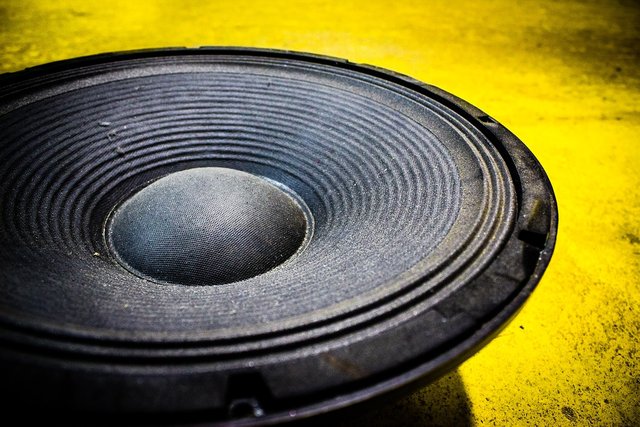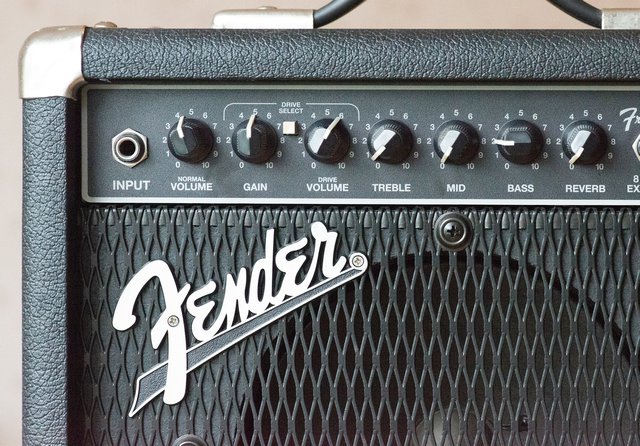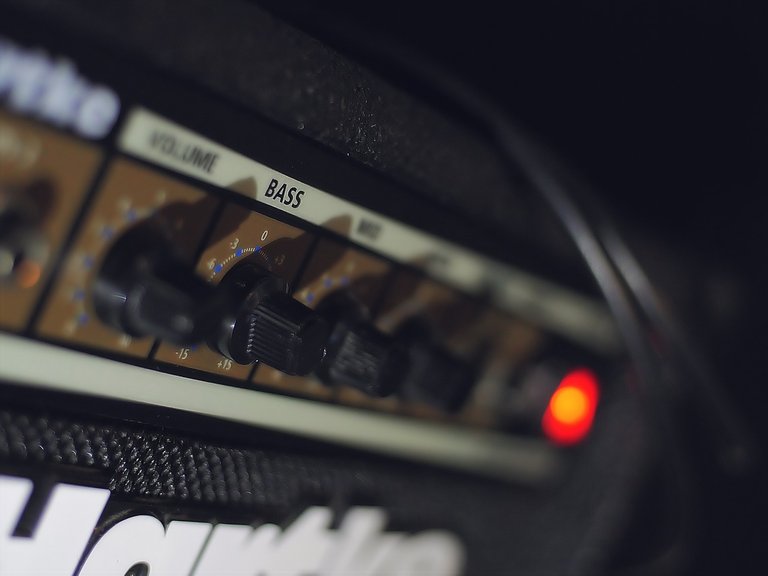Apart from being bigger, heavier and having thicker strings, bass guitars are similar in construction and working to electric guitars. It is natural then to wonder about the amps you have to use with these. Are bass amps and guitar amps the same?
The answer to this is – no.
There are fundamental differences between a bass guitar amplifier and an electric guitar amplifier.
The primary difference is that bass guitar amps typically have a higher power output which can be several folds higher than guitar amps. The second difference is that the speakers are bigger and sturdier in bass amps. Bass frequencies need more air to be pushed out, requiring bigger speakers with more recoil. These bigger speakers, in turn, require a higher current (power output) to drive them. Bass amps are also generally bigger than guitar amps to properly house the bigger speakers and have the acoustics suitable for bass frequencies.
| Bass Amp | Guitar Amp | |
|---|---|---|
| Power output needed | 200-500 watts for most small-to-medium sized gigs | 50-100 watts is loud enough |
| Speaker | Large speakers with sturdier construction | Smaller speakers |
| EQ | The EQ is tuned differently in bass amps to favor the lower end more. It also has different frequency ranges for the low-end, mids and treble, specific to bass guitars | Has a more balanced response to the frequency ranges. The lows, mids and treble ranges are also different |
| Weight | Weighs more because of the larger speakers and magnets | Weighs less |
| Cabinet design | Bass reflex design, with many amps having a ported design | Doesn’t have a ported enclosure |
Bass Amps vs Guitar Amps in Detail
Despite the differences, some musicians use bass and guitar amps interchangeably with bass and electric guitars. To better answer questions like if you can plug a guitar into a bass amp, we’ll first have to learn about the similarities and differences between bass amps and guitar amps.
Let’s learn about these and other less obvious dissimilarities between bass amps and regular amps in detail.
Power Output
Both bass amps and regular guitar amps serve the same purpose: amplifying the electrical signals produced by the pickups in the guitar (or bass). And many features are common in both bass and guitar amps. However, one of the biggest differences is the greater power output needed by bass amps for two reasons.
- Lower (bass) frequencies need to push out more air to be able to produce the sound pressure required for a thumpy bass sound. This, in turn, requires larger speakers with thicker, sturdier cones which naturally need more power to drive them.
- A phenomenon that affects the non-linear increase in perceived volume as opposed to the increase in power in watts. You’re wrong if you think a 100-watt amplifier would sound twice as loud as a 50-watt amp! Doubling the power in watts only increases the loudness by 3dB (decibels). Therefore, to double the perceived loudness (which requires a 10dB increase), you would need a 500-watt amp (10x).
Now think about it – you’d need an amp with 100 times more power to produce a sound four times as loud!
This occurrence is due to a non-linear relationship between the volume we hear and the amp’s power in watts. Of course, this goes for both bass amps and regular guitar amps. But the point is that for the bass guitar to produce the intended thumpy sound that meshes well and cuts through the mix; it needs to be louder, especially than the guitar. And the perception of loudness in humans requires that bass amps have much more power than a beginner might think would suffice.
In short, for most performances, a bassist will need a bass amp 3-8 times more powerful than the guitarist’s amp. Only by playing bass through a bass amp several times higher in power output would it be heard amongst the sound of other instruments in its intended way.
This is why typical guitar amps in the market intended for gigs are rated at 50-100 watts, while bass amps generally are rated much higher at 200-500 watts.
Speaker Size

Bass amps (for gigging) contain speakers ranging from 10 to 15 inches in diameter. Bass amps with 10-inch or smaller speakers, or ones with unusually large power output, may have multiple speakers, while units with larger ones usually only have one large speaker. This is in contrast to guitar amps that may have multiple small speakers, usually 6 inches in diameter.
We must first understand some technicalities to understand why bass amps require larger speakers.
The lowest note or frequency that a standard bass guitar can produce is 41Hz. Furthermore, 5-string bass can go even lower to 31Hz. To produce sound at such low frequencies, the speakers need to generate very high sound pressure levels (this is why you feel a lot of air being pumped out of subwoofer units in your home theater system). This requires bigger speakers and thicker, sturdier cone material to keep up with sound pressure. And as discussed above, these bigger speakers also need more power output from the amplification circuit.
It is one of the reasons bass amps are generally more expensive than guitar amps. Bigger and sturdier speakers specially built for bass frequencies are costlier to manufacture. Since bass amps have specialized speakers, it is not a good idea to hook up a bass guitar to a regular amp unless you’re careful about it.
EQ and Preamp and Effects Unit

The EQ on an amp serves the purpose of boosting or reducing certain frequency ranges. A bass guitar’s frequency range and that of a standard electric guitar are very different, and it also reflects in the EQ.
Bass amps have an EQ unit optimized for the lower frequency range in the sub 80Hz level, while the lowest a regular guitar amp would go is 80Hz and sometimes even higher at around 100Hz.
Bass amps accentuate the lower end more, while the guitar amps have more of a “full-range” response to the frequencies, usually favoring the mid and high-end frequencies and going as high as 2000Hz, while bass amps have a typical cap at around 500Hz.
Overall Size and Weight
In order to accommodate the larger speakers and acoustics required to produce lower-frequency sound output more efficiently, a larger cabinet is needed.
Furthermore, the larger speaker units also require bigger and heavier magnets which add to the overall weight of the bass amps. As a result, guitar amps are generally smaller and less bulky than bass amps. Due to the size and weight of bass amps, they are also more challenging to transport.
The transportation problem faced by bassists is one of the reasons why some musicians may prefer to use a guitar amp for playing their bass, especially in smaller gigs.
Cabinet Design
Another difference between a bass amp and a guitar amp is the cabinet structure or design (usually internal).
Most bass amps have a bass-reflex cabinet with a vent with tubing inside to increase the speakers’ efficiency in the lower-frequency range. The vent helps the sound waves from behind the speaker cone to come out, thereby increasing the efficiency compared to a sealed enclosure.
Does the subwoofer in your home theater system have a vent? Well, that is an example of bass-reflex design.
On the other hand, guitar amps generally do not have any vents and have a sealed enclosure.
Can You Use a Double Bass (Upright Bass) with Bass Amps?
The double bass, a large instrument with a fundamentally different sound pickup mechanism, is considered a predecessor to bass guitars.
Also called upright bass, double bass uses a piezoelectric pickup rather than a magnetic pickup that most bass guitars use. Due to the difference in impedance between these pickups, most bass amplifiers cannot directly produce the intended sound output when connected to double bass. To match the impedance, you need to use a specialized preamp that acts as a bridge between the double bass and the bass amp.
Bass Amps vs Guitar Amps – Frequently Asked Questions
Can I plug a guitar into a bass amp?
Yes. In fact, many guitarists in certain genres prefer to use bass amps over guitar amps for their electric guitars.
Technically speaking, there is little to no issues with using a bass amp for the guitar. But, from what you have learned in this post, the tonality will be different than a standard guitar amp. Whether or not it will produce the intended sound depends on the genre of music and the song you're trying to play.
Some people like the sound of their guitar through a bass amp, while others don't. The legendary Fender Bassman, for example, has been more popular among guitarists rather than bassists.
Can I plug a bass guitar into a guitar amp?
Yes, you can make your guitar amp work with a bass guitar, provided you take some precautions.
Final Thoughts
Through technological advancements, both bass amps and guitar amps have become pretty safe to be used interchangeably. However, from what we have learned, there are differences between a bass amp and a guitar amp, and the best sound can be achieved when the instrument is paired with its intended amplifier.
As with many things in music, there are no hard and fast rules, and the majority of rules are meant to be broken. This is why some musicians prefer to hook their guitars with bass amps, and others like the sound of their bass through guitar amps.
Find out how you like to play your instrument and make that your signature. We wish you well in your music pursuits!


